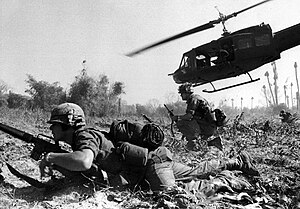| Battle of Ia Drang Valley | |||||||
|---|---|---|---|---|---|---|---|
| Part of the Vietnam War (Operation Silver Bayonet I, Pleiku campaign 1965) | |||||||
 U.S. Army soldiers air-lifted into LZ X-Ray. | |||||||
| |||||||
| Belligerents | |||||||
|
Supported by: |
| ||||||
| Commanders and leaders | |||||||
|
Richard T. Knowles 1st Air Cavalry Division Fwd CP[2]: 210 Tim Brown 3rd Air Cavalry Brigade[2]: 202 Harold G. Moore, 1st Battalion, 7th Cavalry Robert McDade, 2nd Battalion, 7th Cavalry Robert B. Tully, 2nd Battalion, 5th Cavalry |
Nguyễn Hữu An B3 Field Front Fwd CP[3]: 34 Phạm Công Cửu 66th Regiment Deputy Cmdr Lã Ngọc Châu 7/66 Lê Xuân Phôi 8/66 † Nguyễn Văn Định 9/66 | ||||||
| Units involved | |||||||
|
|
| ||||||
| Strength | |||||||
|
Total: ~1,000 U.S. cavalry troops[7] and ~900 ARVN troops[1]: 129 Two batteries of artillery[5] Elements of multiple aircraft and helicopter support units flew 740 CAS sorties, along with 5 B-52 missions with 96 sorties[5] |
Total: ~2,500 troops[8] | ||||||
| Casualties and losses | |||||||
|
|
U.S. claimed: 1,037–1,745 killed PAVN report: 554 killed and 669 wounded (~49% of troop strength)[10] | ||||||
| See Casualties section | |||||||
The Battle of Ia Drang (Vietnamese: Trận Ia Đrăng, [iə̯ ɗrăŋ]; in English /ˈiːə dræŋ/) was the first major battle between the United States Army and the People's Army of Vietnam (PAVN), as part of the Pleiku campaign conducted early in the Vietnam War, at the eastern foot of the Chu Pong Massif in the central highlands of Vietnam, in 1965. It is notable for being the first large scale helicopter air assault and also the first use of Boeing B-52 Stratofortress strategic bombers in a tactical support role. Ia Drang set the blueprint for the Vietnam War with the Americans relying on air mobility, artillery fire and close air support, while the PAVN neutralized that firepower by quickly engaging American forces at very close range.
Ia Drang comprised two main engagements, centered on two helicopter landing zones (LZs), the first known as LZ X-Ray, followed by LZ Albany, farther north in the Ia Drang Valley.
LZ X-Ray involved the 1st Battalion, 7th Cavalry Regiment and supporting units under the command of Lieutenant Colonel Hal Moore, and took place November 14–16, at LZ X-Ray. Surrounded and under heavy fire from a numerically superior force, the American forces were able to hold back the North Vietnamese forces over three days, largely through the support of air power and heavy artillery bombardment, which the North Vietnamese lacked. The Americans claimed LZ X-Ray as a tactical victory, citing a 10:1 kill ratio.
The second engagement involved the 2nd Battalion, 7th Cavalry Regiment plus supporting units under the command of Lieutenant Colonel Robert McDade, and took place on November 17 at LZ Albany. When an American battalion was ambushed in close quarters, they were unable to use air and artillery support due to the close engagement of the North Vietnamese and the Americans suffered a casualty rate of over 50% before being extricated. Both sides claimed victory.
The battle at LZ X-Ray was documented in the CBS special report Battle of Ia Drang Valley by Morley Safer and the critically acclaimed book We Were Soldiers Once... And Young by Hal Moore and Joseph L. Galloway. In 1994, Moore, Galloway and men who fought on both the American and North Vietnamese sides, traveled back to the remote jungle clearings where the battle took place. At the time the U.S. did not have diplomatic relations with Vietnam. The risky trip which took a year to arrange was part of an award-winning ABC News documentary, They Were Young and Brave produced by Terence Wrong. Randall Wallace depicted the battle at LZ X-Ray in the 2002 movie We Were Soldiers starring Mel Gibson and Barry Pepper as Moore and Galloway, respectively.
Galloway later described Ia Drang as "the battle that convinced Ho Chi Minh he could win".
- ^ a b c Vinh Loc
- ^ a b Moore, Harold; Galloway, Joseph (1992). We Were Soldiers Once... and Young. Harper Torch. ISBN 0-679-41158-5.
- ^ Cite error: The named reference
NguyenHuuAnwas invoked but never defined (see the help page). - ^ a b Stanton, Vietnam Order of Battle, page 73
- ^ a b c d "Archived copy" (PDF). Archived from the original (PDF) on 2011-07-19. Retrieved 2009-11-28.
{{cite web}}: CS1 maint: archived copy as title (link) - ^ Kinnard, page i
- ^ Kennedy Hickman. "Vietnam War – Battle of Ia Drang (1965)". About.com Education. Archived from the original on 2015-09-16. Retrieved 2014-10-03.
- ^ Vinh Loc, page 112
- ^ ARVN report, G3 Journal, I First Field Force, Oct 19-Nov 27, 1965.
- ^ "Công tác hậu cần trong Chiến dịch Plâyme năm 1965". www.qdnd.vn.